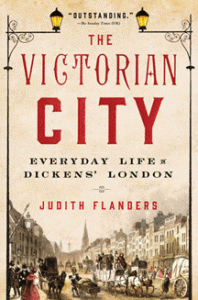Exclusive interview with author Judith Flanders and a review of her new book about surviving in Victorian London
Rating Three Stars
By Gabrielle Pantera
“First rule of writing, nothing ever happens to writers in real life that is half as interesting as what happens in our heads,” says The Victorian City author Judith Flanders. “My second book, The Victorian House, was a look at how people used their houses in the 19th century… what they did all day, how they did all the routine things we take for granted, cooked, did laundry, who used what rooms and so on. Once I’d done that, The Victorian City really was the obvious next step, even if it took me a while to get to it. This let me spread out from what did people do in their houses, to what did they do when they were out of their houses, how did they move around the city, how did they use the streets, surprisingly differently to us, as it turns out, and what happened outside.”
The Victorian City is about the darker side of Victorian London….or Dickensian London. Dickens was about 25 when the Victorian Age started. In1830 the upper class went to the theater, shopped at fine stores, and the men had their private clubs and courtesans. At this time men still had all the power and even after Victoria became Queen it was thought that she was ruled by the men in her life. Upper class and wealthy women didn’t go out without a maid or servants with them for protection. In Flanders’ book the lower classes barely survive. The streets are choked with people…vendors, newspaper boys, the homeless, tinkers, chimney sweeps, prostitutes, pickpockets, and shoppers. Smog hangs over the city and the Thames is a sewer.
“The British Library has, don’t tell my mother, an amazing collection of 19th-century pornography,” says Flanders. “Which was key to my chapter on street-prostitution. The downside of that is that the material is very, very rare, and it all has to be read at a special desk where the librarians can watch to make sure it isn’t stolen. I felt like everyone in the building knew I was reading guides to 19th century brothels.”
“For The Victorian City I also relied on the memoirs of tourists,” says Flanders. “People who live in a place often don’t notice things, because they’re used to them, whereas strangers find them odd and interesting. So I read dozens and dozens of accounts of trips by American visitors, who remarked on novelties like omnibuses. One of them told me how you got up onto the driver’s seat of a bus, which I’d never been able to work out.”
Flanders’ previous book The Invention of Murder was used as the basis for a BBC series called A Very British Murder. Flanders was shortlisted for the Guardian First Book Award, and The Victorian House was shortlisted for the British Book Awards History Book of the Year.
Flanders’ first book was A Circle of Sisters, a biography of four Victorian women. She has mostly written about social history,with books on domestic life,leisure industries,and on how murder became the basis for entertainment in the 19th century. She’s written a crime novel set in a publishing house in contemporary London to be published in the U.S.next spring.
Judith Flanders was born and lives in London, but was raised in Montreal. As a consequence she has a Canadian accent and says she thinks of herself as Canadian. Her website is www.judithflanders.co.uk
The Victorian City: Everyday Life in Dickens’ London by Judith Flanders. Hardcover: 544 pages, Publisher: Thomas Dunne Books; Reprint edition (July 15, 2014). Language: English, ISBN: 9781250040213 $27.99
